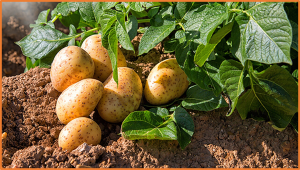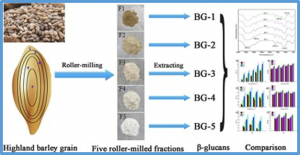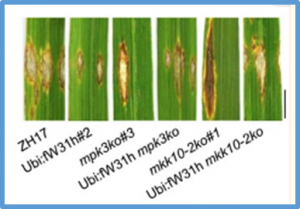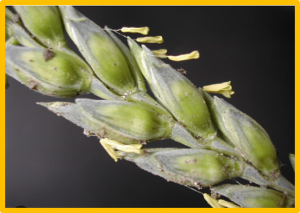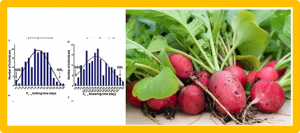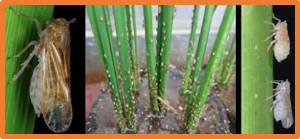This work identified altogether 74 PUBs in the potato (StPUBs) and examined their gene structures, chromosomal distributions, and conserved motifs. There were seventy-four StPUB genes on ten chromosomes with diverse densities. As revealed by phylogenetic analysis on PUBs within potato, Arabidopsis, tomato (Solanum lycopersicum), cabbage (Brassica oleracea), rice (Oryza sativa), and corn (Zea mays), were clustered into eight subclasses (C1-C8)
Barley grains are rich in β-glucan, an important factor affecting end-use quality. Previously, we identified several stable marker-trait associations (MTAs) and novel candidate genes associated with β-glucan content in barley grains using GWAS (Genome Wide Association Study) analysis. The gene HORVU3Hr1G096910, encoding β-glucosidase 3, named HvBGlu3, is found to be associated with β-glucan content in barley grains.
Mitogen-activated protein kinase (MPK) cascades play vital roles in plant innate immunity, growth, and development. Here, we report that the rice (Oryza sativa) transcription factor gene OsWRKY31 is a key component in a MPK signaling pathway involved in plant disease resistance in rice. We found that the activation of OsMKK10-2 enhances resistance against the rice blast pathogen Magnaporthe oryzae and suppresses growth through an increase in jasmonic acid and salicylic acid accumulation and a decrease of indole-3-acetic acid levels
Spike architecture is a key determinant of wheat yield, a crop which supports much of the human diet but whose yield gains are stagnating. Spike architecture mutants offer opportunities to identify genetic factors contributing to inflorescence development. Here, we investigate the locus underlying the compact spike phenotype of mutant line ANK-15 by conducting mRNA-sequencing and genetic mapping using ANK-15 and its non-compact spike near-isogenic line Novosibirskaya 67 (N67).
Radish (Raphanus sativus L.) is an important vegetable crop of Cruciferae. The premature bolting and flowering reduces the yield and quality of the fleshy root of radish. However, the molecular mechanism underlying bolting and flowering in radish remains unknown. In YZH (early bolting) × XHT (late bolting) F2 population, a high-density genetic linkage map was constructed with genetic distance of 2497.74 cM and an average interval of 2.31 cM. A total of nine QTLs for bolting time and two QTLs for flowering time were detected. Three QTLs associated with bolting time in radish were identified by QTL-seq using radish GDE (early bolting) × GDL (late bolting) F2 population.
Salinity stress progressively reduces plant growth and productivity, while plant has developed complex signaling pathways to confront salt stress. However, only a few genetic variants have been identified to mediate salt tolerance in the major crop rice, and the molecular mechanism remains poorly understood. Here, we identify ten candidate genes associated with salt-tolerance (ST) traits by performing a genome-wide association analysis in rice landraces. We characterize two ST-related genes, encoding transcriptional factor OsWRKY53 and Mitogen-activated protein Kinase Kinase OsMKK10.2, that mediate root Na+ flux and Na+ homeostasis.
Bean pod phenotype is a complex characteristic defined by the combination of different traits that determine the potential use of a genotype as a snap bean. In this study, the TUM RIL population derived from a cross between ‘TU’ (dry) and ‘Musica’ (snap) was used to investigate the genetic control of pod phenotype. The character was dissected into pod morphological traits (PMTs) and edible pod characteristics (EPC). The results revealed 35 QTL for PMTs located on seven chromosomes, suggesting a strong QTL colocation on chromosomes Pv01 and Pv06. Some QTL were colocated with previously reported QTL, leading to the mapping of 15 consensus regions associated with bean PMTs.
Identification of genes that confer multiple disease resistance (MDR) is crucial for the improvement of maize disease resistance. However, very limited genes are identified as MDR genes in maize. In this study, we characterized a dominant disease lesion mimics 8 (Les8) mutant that had chlorotic lesions on the leaves and showed enhanced resistance to both curvularia leaf spot and southern leaf blight.
Gene expression levels in allopolyploid plants are not equivalent to the simple average of the expression levels in the parents and are associated with several non-additive expression phenomena, including homoeolog expression bias. However, hardly any information is available on the effect of homoeolog expression bias on traits. Here, we studied the effects of gene expression-related characteristics on agronomic traits using six isogenic resynthesized Brassica napus lines across the first ten generations
Brown planthopper (BPH), a monophagous phloem feeder, consumes a large amount of photoassimilates in rice and causes wilting. A near-isogenic line ‘TNG71-Bph45’ was developed from the Oryza sativa japonica variety ‘Tainung 71 (TNG71) carrying a dominant BPH-resistance locus derived from Oryza nivara (IRGC 102165) near the centromere of chromosome 4. We compared the NIL (TNG71-Bph45) and the recurrent parent to explore how the Bph45 gene confers BPH resistance.


 Curently online :
Curently online :
 Total visitors :
Total visitors :
